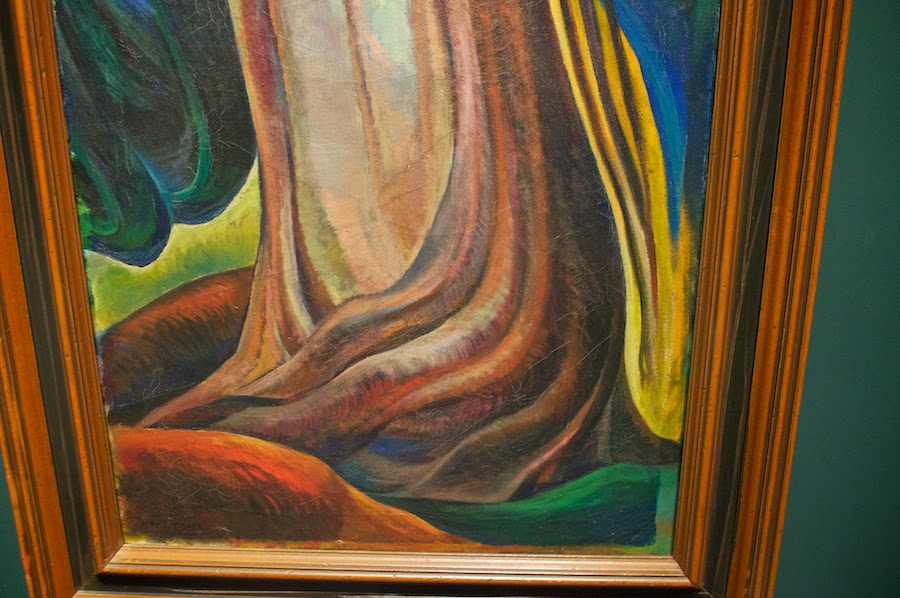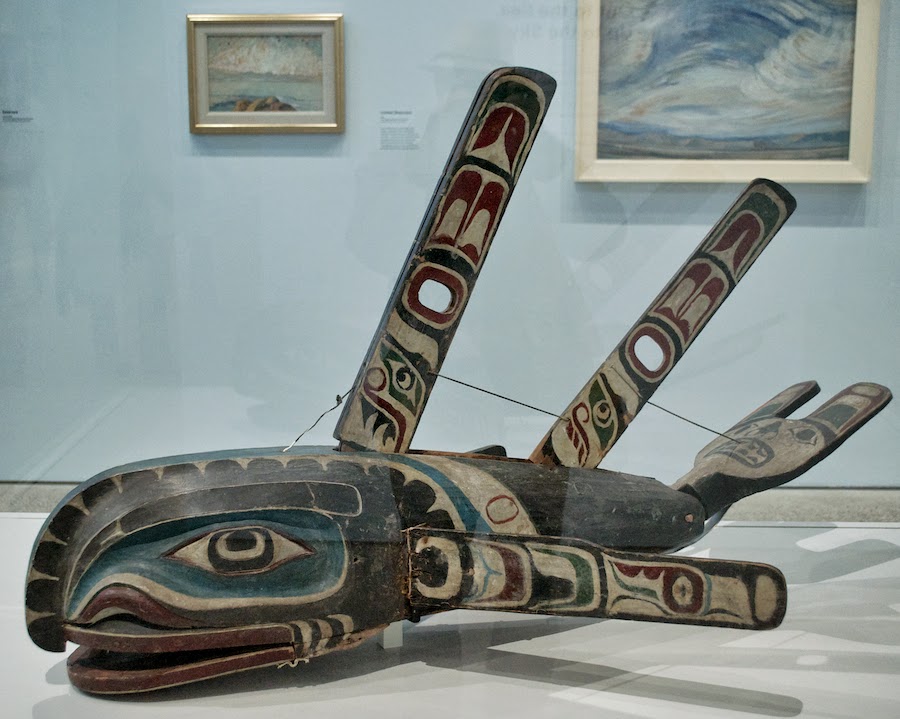Thursday, April 30, 2015
Friday, April 10, 2015
Emily Carr at the AGO
Bill and I went to the Emily Carr show yesterday at the AGO. The show is superb -- exciting, fresh, and inspiring.
Tree Trunk (1931, oil on canvas) is the first painting you will see as you enter. The wall texts, which are brief and helpful, say that Carr painted this after meeting and being inspired by Georgia O'Keefe.
Here's a detail.
Expect glorious watercolours like Tsatsisnukomi, B.C. from 1912
and Tribe Klawatsis, Karlukwees Village, also from 1912.
I was struck by the freshness of the miniature works like this early watercolour Indian Canoes in Harbour, from around 1895.
You could hold Carr's Victoria Sketchbook, from 1898, in the palm of your hand.
The main room is full of wonders -- Carr's famous paintings of the lives and art works of Canada's West Coast Native People. She started work on them after meeting the members of the Group of Seven and being encouraged by Lauren Harris.
That's Blunden Harbour (around 1930) on the left, Silhouette No. 2. (1930-31) on the right.
Left: Ankeda, The Pole of Chief George Kindealda, 1928. Right: Grizzly Bear Totem, Angidah, Nass River, around 1930.
We loved the West Coast traditional masks. Kwakwaka'wakw: Dzawada'enuxw artist. Weather Dance Mask, before 1952. Wood, fibre, metal and paint.
Kwakwaka'wakw Artist. Deer Mask, date unknown. Wood, paint, abalone shell and metal.
Raven Frontlet, date unknown. Wood, jute fibre and paint.
Kwakwaka'wakw: Gwa'sala Artist. Bear Mask, before 1953. Wood, bear skin, paper, paint and metal.
Bill and I were drawn to a wall containing some gloriously translucent paintings in which Carr mixed her paint with gasoline. Here's Forest Landscape No. 2, from around 1935.
Forest Interior, around 1936
Windswept Trees, around 1937-38.
Detail from Windswept Trees. Those brushstrokes!
Two details from Sunshine and Tumult, 1939.
From the same year: Trees in the Sky and Above the Trees, around 1939.
Detail from Trees in the Sky.
Left: Forest Scene, around 1938-1945. Right: Trees, around 1939-45. Both ink drawings on paper.
The wall text describes Forest, British Columbia (1940) as muscular. I like that. Carr gave it to another of her mentor's Group of Seven painter Lawren Harris, who treasured it.
John Davis, Whale Mask, before 1919. wood, leather skin, metal and fibre.
Carr's late paintings were inspired by the sea and sky. Stumps and Sky, around 1934. Oil on paper
Stumps and Sky (detail)
Let's end today's tour with one final masterpiece: Scorned as Timber, Beloved of the Sky, 1935.
***
From the Forest to the Sea: Emily Carr in British Columbia was a cooperative effort between the AGO and the Dulwich Picture Gallery, London, where it opened to great acclaim last November. Our gratitude for the brilliance and taste of the curators: Canadian art critic and journalist Sarah Milroy and Sackler Director of the Duwich, Ian Dejardin. It's worth the drive to Toronto.
Stumps and Sky (detail)
Let's end today's tour with one final masterpiece: Scorned as Timber, Beloved of the Sky, 1935.
***
From the Forest to the Sea: Emily Carr in British Columbia was a cooperative effort between the AGO and the Dulwich Picture Gallery, London, where it opened to great acclaim last November. Our gratitude for the brilliance and taste of the curators: Canadian art critic and journalist Sarah Milroy and Sackler Director of the Duwich, Ian Dejardin. It's worth the drive to Toronto.
Subscribe to:
Comments (Atom)









































.jpg)
